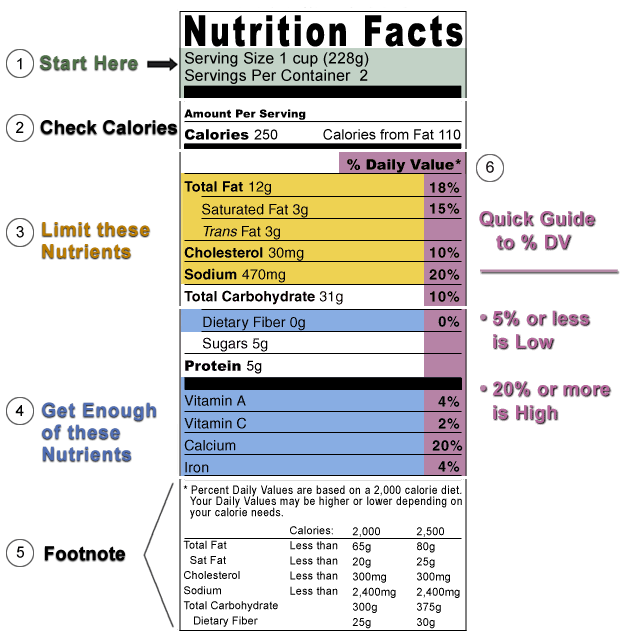Winnsboro Medical Clinic>Nutrition>Reading Nutrition Labels
The Nutrition Fact label is a great tool to help make informed food decisions for a healthier diet. Follow the numbered and color-coded sample label below to learn how to get started.
1 – Serving Size
- Tells you how much food counts as a single serving. All the nutritional information on the the label is for ONE serving.
- Be sure to take note of how many servings are in the package.
- Ask yourself how much you eat/drink in a single helping.
- In the case of the sample above: there are 2 servings in this package. 1 serving has 12g of Fat, 2 servings has 24g of Fat, etc…
2 – Calorie Content
- The number of Calories tells you how much energy you get from a single serving of food/drink. It also tells you how much of those Total Calories is from Fat.
- Depending on your diet goals, take note of about how many calories you are eating in a day. Remember that calories = energy and energy not used will be stored in the body and lead to weight gain.
- In the case of the sample above: there are 250 calories in 1 serving. Of those 250 calories, 110 of them are from Fat.
3 & 4 – The Nutrients
- Lists the main nutrients (carbohydrates, fats, proteins, etc…) and their amounts in each serving.
- YELLOW nutrients: These are nutrients that most Americans eat in adequate or excessive amounts. Try to limit your intake of these nutrients to the daily recommended amount.
- Total Fat takes into account 3 types of Fat: saturated, unsaturated, and trans fats. Try to have unsaturated fats make up most of your daily fat intake. It is recommended to eat as little trans fats as possible.
- BLUE nutrients: These are nutrients that most Americans do not get enough of from their diet. Increasing your daily intake of these nutrients may also improve your health and reduce your risk for some chronic diseases/conditions.
- Notice that for minerals and vitamins there are no weights listed but only daily percentages. Ex: One serving contains 20% of the day’s Calcium intake
5 – The Footnote
- This footnote is standard among all nutrition labels and is required to be on every label. The values within the footnote are not representative of the food product within the package. The footnote really describes how much of each nutrient is found in a 2000 or 2500 calorie daily diet.
- So in the above label, a 2000 calorie daily diet should contain less than 20 grams of Saturated Fat (and similarly for the other nutrients listed).
- Read the Percent Daily Values (Step 6) to see how this particular food fits within your daily goals.
6 – Percent Daily Values
- Most people are unaware about whether they eat enough or too much of a certain nutrient, such as Fat, Cholesterol, or Vitamins. The % Daily Value represents recommendations for select nutrients but only based off a 2000 calorie per day diet. These daily values are listed in the Footnote at the bottom of the label (Step 5).
- Adding up all the percentages on the label from top to bottom will not add up to 100%. The % Daily Value for each nutrient is specific to that nutrient. For example, in the above sample label, the label shows that this food contains 20% of your daily recommended intake of Sodium (Salt) in ONE serving. So as a general guide, you should have about 80% of your day’s salt intake left for all the other foods you will eat that same day.
- If each serving contains 20% of your daily recommended sodium amount, then eating 5 servings should give you all of your day’s recommended sodium intake.
- The % Daily Value is a great tool to determine whether a particular food/drink is high/medium/low in a specific nutrient, especially when it is difficult to visualize how much X grams actually is. In general:
- LOW = 5% or less
- HIGH = 20% or more
- Looking at the nutrients in 3 & 4, try to include more foods that are HIGH in those in #4 (fiber, vitamins/minerals, etc…) and LOW in those that are in #3 (Fats, cholesterol, etc…) into your daily diet.
Tips
- At the grocery store, get used to comparing labels in order to start making healthier food choices. First start with similar food items, such as Reduced Fat and Whole Milk.
- Try and minimize the amount of trans fat, saturated fat, cholesterol, and sugar in your diet. Notice that there is no % Daily Value for trans fat, sugar, or protein.
- There is no % Daily Value for Protein because most Americans get adequate amounts of protein and most people do not suffer from low protein diets.
- Diets high in Trans and Saturated Fats are linked with obesity and heart disease.
- Remember that the sugar value includes naturally occurring sugar, such as that found in milk and fruit, as well as sugar that is added to the food. Try to stick to foods with high amounts of naturally occurring sugar and NOT added sugar. Foods with lots of added sugars provide lots of energy but little other nutrients with it. Read the Ingredients List for these alternative names for added sugars:
- corn syrup, high-fructose corn syrup, fruit juice concentrate, maltose, dextrose, sucrose, honey, maple syrup.

